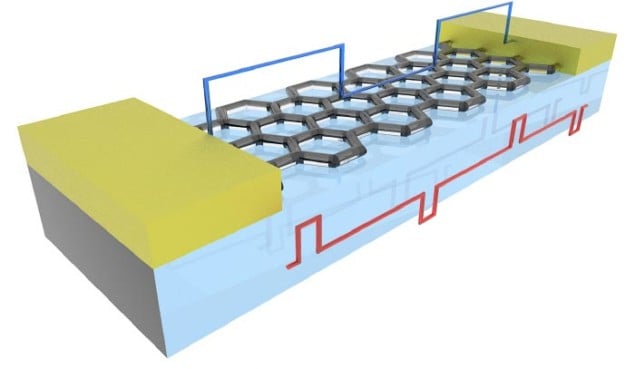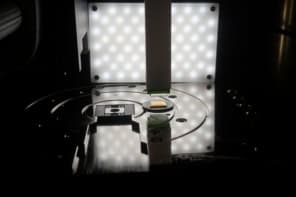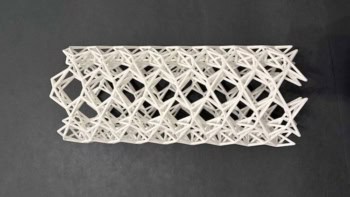
A new memory cell made of an extremely narrow graphene “nanoribbon” has been unveiled by researchers in Germany, Switzerland and Italy. An important benefit of the new cell is that it can be made much smaller than a conventional silicon cell, resulting in memory chips with much greater storage density than silicon-based devices.
The most important property of a memory chip is its capacity, that is, the amount of information it can store. To satisfy the demand for more powerful computers, the capacity of memory chips per chip area (also known as their storage density) has been increasing exponentially over the last 20 years – so obeying Moore’s law.
Storage density ultimately depends on the size of a unit memory cell (the smaller the better), which stores one bit of information, 0 or 1. Preserving Moore’s law will thus depend on how good scientists are at fabricating ever smaller unit memory cells. Graphene – a 2D sheet of carbon just one atom thick – is a promising material in this respect thanks to its exceptional electronic and mechanical properties because it could allow devices smaller than 10 nm to be made. 10 nm is around the dimension at which devices based on silicon reach their limits.
Reaching the 10 nm scale
Roman Sordan of the Politecnico di Milano and colleagues in Stuttgart and Lausanne have now reached the 10 nm scale by making a memory cell based on graphene nanoribbons – the form of graphene that has the smallest possible area. “Indeed, the area of our new memory cell is so small that it allows for a very high storage density,” Sordan said. “We thus expect that graphene nanoribbon memory chips will allow Moore’s law to continue for the foreseeable future.”
The team fabricated graphene nanoribbons by depositing V2O5 nanofibres atop graphene and then etching the sample using an argon ion beam. The ion beam removes any graphene not protected by the nanofibres. This simple method forms graphene nanoribbons underneath the nanofibres, which are subsequently removed.
Very narrow nanoribbons
The advantage of using nanofibres as etching masks is that the technique can produce very narrow nanoribbons that are less than 20 nm wide. The ribbons also have smoother edges that those made by standard lithography. Rough edges usually degrade the characteristics of a device.
Another advantage of using V2O5 fibres is that they can easily be removed once the ribbons have been patterned – you just need to flush the sample with water, which is a simple and environmentally friendly process, said Sordan.
The researchers found that gate voltage pulses of opposite signs can switch the device between digital on (bit 1) and off (bit 0) states. After the device flips, it remains in the new state even after the gate voltage is reset – that is, it can “remember” its state. “This memory effect probably originates from charges surrounding the nanoribbons, which are trapped by water molecules adsorbed on the SiO2 substrate on which the devices were made,” explained Sordan. “The nanoribbons possess a memory effect most likely due to a simple mechanism by which water vapour from the air attaches to the hydrophilic substrate and then traps charges in the vicinity of the nanoribbons.”
Small and very fast
The device has a transition time (the time a device needs to flip its memory state once triggered) that is three orders of magnitude shorter than that of previously reported memory devices made from either graphene or carbon nanotubes. The transition time is directly related to the highest frequency at which the device can be clocked. This means that the shorter the transition, the higher the clock rate – an important point because memory devices not only need to be small but also very fast, says Sordan.
“Our memory cells are also very robust and versatile,” he added. “They can be used as both static random access memories and nonvolatile flash memories cell for ultrahigh storage density applications.”
The researchers, who have published their work in Small, will now try to develop digital logic gates based on graphene nanoribbons – the other important class of devices needed to realize all-graphene computers. “We have already made graphene logic gates but think that those made from nanoribbons will be better.”



